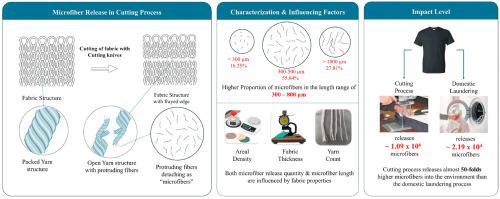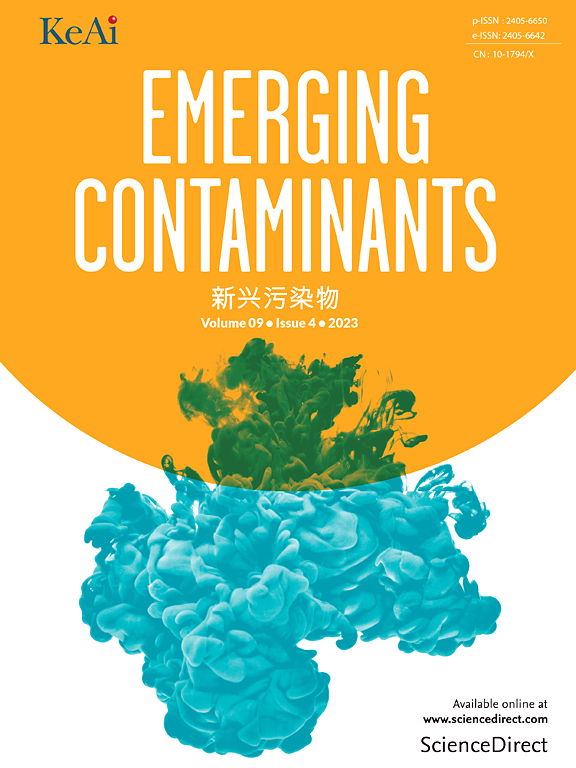服装制造过程中的超细纤维释放——比家庭洗衣更令人担忧
IF 6.9
2区 环境科学与生态学
Q1 ENVIRONMENTAL SCIENCES
引用次数: 0
摘要
纺织材料中释放的微纤维作为近年来最重要的人为污染物之一,已成为人们迫切关注的问题。虽然据报道,家庭洗衣是释放超细纤维的主要来源,但研究人员强调,制造阶段的潜力也同样重要。然而,在制造阶段进行的研究有限。为了弥补这一差距,本研究旨在分析服装制造业中不同针织面料在切割过程中释放的超细纤维。在切割过程中释放的微纤维通过工业内外的大气沉积法收集。结果表明:在切割过程中,每平方米切割地板每天平均沉积2.86 × 106±6.02 × 105根微纤维;观察到被切割织物的长度与微纤维沉积之间存在很强的线性关系(r = 0.96)。在织物性能方面,针脚密度、厚度、面密度和纱支之间存在很强的正相关关系(r = 0.80 ~ 0.99),表明这些参数的增加会导致超细纤维排放量的增加。相反,与环长呈负相关(r = - 0.79),与紧度因子相关性不显著(r = 0.49)。大多数释放的光纤长度在300 ~ 800 μm之间(55.84%)。结果表明,结构紧凑的织物比结构松散的织物释放出更多的短超纤维。研究结果表明,裁剪一件中等大小的t恤会释放出高达1.09 × 106的微纤维,比洗衣时释放出的微纤维高出约50倍,其中40 - 70%的纤维被运送到工厂外。鉴于这一惊人的数量,未来的研究应侧重于了解接触大量微纤维的切割操作员的职业危害。此外,研究应侧重于开发具有成本效益的替代切割方法和可在工业中实施的微纤维捕获系统,以控制微纤维释放到外部环境中。本文章由计算机程序翻译,如有差异,请以英文原文为准。

Microfiber release during apparel manufacturing process – A greater concern than domestic laundering
Microfibers released from textile materials have recently become a pressing concern as one of the most significant anthropogenic pollutants in recent times. Although domestic laundry has been reported as a major source of microfiber release, researchers stress the potential of manufacturing stage to contribute equally. However, limited research has been conducted on the manufacturing stage. To bridge this gap, the current study aimed to analyze microfiber release from different knitted fabrics during the cutting process in the apparel manufacturing industry. Microfibers released during cutting were collected using the atmospheric deposition method both inside and outside the industry. The findings revealed that the cutting process caused an average microfiber deposition of 2.86 × 106 ± 6.02 × 105 microfibers per square meter of cutting floor per day. A strong linear relationship was observed between the length of the fabric been cut and microfiber deposition (r = 0.96). Regarding fabric properties, strong positive correlations (r = 0.80 to 0.99) were noted with stitch density, thickness, areal density, and yarn count, indicating that increase in these parameters led to increased microfiber emissions. Conversely, a negative correlation was reported for loop length (r = −0.79), and an insignificant correlation was found with the tightness factor (r = 0.49). The majority of the released fibers (55.84 %) measured between 300 and 800 μm in length. The results showed that fabrics with compact structures released more short microfibers than those with loose structures. The study's findings indicated that cutting a medium-sized T-shirt can release up to 1.09 × 106 microfibers, which is approximately 50 times higher than that released during laundry, with 40–70 % of the fibers transported outside the factory. With this alarming quantity, future research should focus on understanding the occupational hazards of cutting operators exposed to large quantities of microfibers. Moreover, studies should focus on developing cost-effective alternative cutting methods and microfiber-capturing systems that can be implemented in the industry to control the release of microfibers into the external environment.
求助全文
通过发布文献求助,成功后即可免费获取论文全文。
去求助
来源期刊

Emerging Contaminants
Medicine-Public Health, Environmental and Occupational Health
CiteScore
10.00
自引率
6.70%
发文量
35
审稿时长
44 days
期刊介绍:
Emerging Contaminants is an outlet for world-leading research addressing problems associated with environmental contamination caused by emerging contaminants and their solutions. Emerging contaminants are defined as chemicals that are not currently (or have been only recently) regulated and about which there exist concerns regarding their impact on human or ecological health. Examples of emerging contaminants include disinfection by-products, pharmaceutical and personal care products, persistent organic chemicals, and mercury etc. as well as their degradation products. We encourage papers addressing science that facilitates greater understanding of the nature, extent, and impacts of the presence of emerging contaminants in the environment; technology that exploits original principles to reduce and control their environmental presence; as well as the development, implementation and efficacy of national and international policies to protect human health and the environment from emerging contaminants.
 求助内容:
求助内容: 应助结果提醒方式:
应助结果提醒方式:


